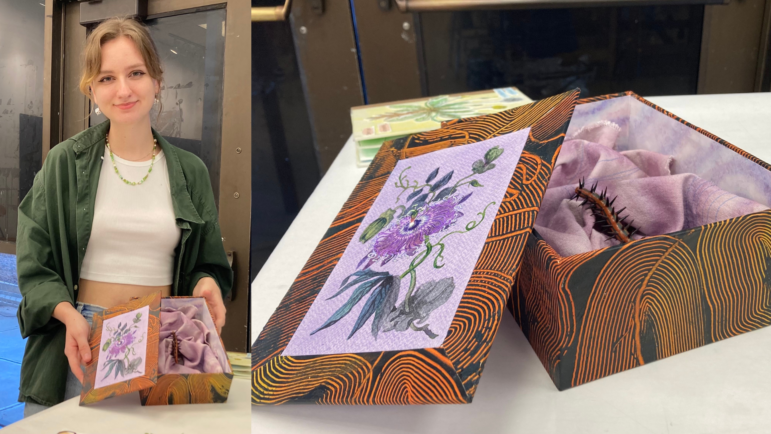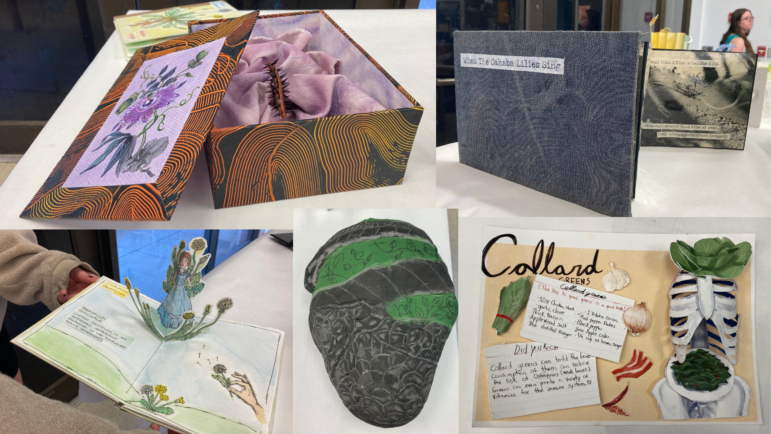This story is part of a monthly series called Outdoor Connections, which features stories that explore the biodiversity of Alabama and how we depend on it.
About a dozen students spread out across a classroom, working with wheat paste and a special type of adhesive to measure and shape materials.
Behind them, lining the back wall, is a table full of botanical artwork.
Rachel Doyle points to a handcrafted box made of swirly patterned paste paper.
“I made this one here,” said Doyle, a junior studying graphic design. “It is about the passion flower.”
The box’s lid features a watercolor of the strange looking purple flower, which is said to help ease anxiety.
Doyle was interested to learn that the passion flower is a host plant for a spiky orange caterpillar, which she likens to a visual representation of anxiety. She sculpted a clay replica of the insect and placed it inside the box atop a piece of dyed linen cloth.
“To me, the inside of the box is kind of like the internal body,” Doyle said. “So the effects of the flower, the calming effects, it’s almost like the caterpillar’s being calmed down. The anxiety is being calmed.”

Doyle is one of roughly 70 students who recently created artwork inspired by curative plants found in Alabama.
The project is led by three UAB art professors, including Doug Baulos, associate professor of drawing and bookmaking.
Baulos has studied and written about the healing power of nature, and said he wants more people to appreciate Alabama’s incredible biodiversity.
“We have a lot of access to some real luxuries,” he said. “Sometimes artwork can kind of be the signpost towards that luxury in a really positive way.”
Baulos said the curative plants assignment combines art, history and science. Students studied early botanical drawings and photography using books and illustrations from the 19th century. And they attended a lecture by a local medicinal plants expert to learn more about their historical use in Alabama.
Students then chose one plant to research and depict through artwork.
Faith Potter, a senior graphic design student, crafted a colorful pop-up book with detailed information about how to use the elderflower plant.
“I wanted to talk about the entire process of harvesting and getting it, making tea and just how that helps the entire body,” Potter said.
Elderflower berries are thought to ease cold and flu symptoms. Potter was also interested in claims that the plant can help relieve pain and reduce inflammation.
“My mom has lupus, and so I was looking for a plant that would specifically cure arthritis,” she said.
Students highlighted a range of plants, including dandelion flowers, collard greens and Cahaba lilies.
Derriann Pharr, a junior studying drawing, studied the Lunaria plant, also known as the money plant or the silver dollar plant.
“The petals from the plant, they have these little bulbs, and when they dry out completely, they almost look luminescent, like the moon,” Pharr said.
She created a star book inspired by the alleged spiritual healing powers of Lunaria, which people historically used to help ward off nightmares.
“They would take the pods and tuck them into little dream pillows with other herbs and stuff and tie them up and put them under pillows,” Pharr said. “And it was said to kind of reflect bad dreams away. So I decided to make something that kind of held my dreams that I feel like I’ve had.”
Pharr’s book includes images of snakes, family memories and a portion of a prayer.
The piece, along with the entire collection of botanical artwork, will soon be on display at the Mervyn Sterne Library.
EDITOR’S NOTE: UAB holds WBHM’s broadcast license, but our news and business departments operate independently.
Do you have an idea worth featuring as part of our Outdoor Connections series? Email maryscott@wbhm.org.


